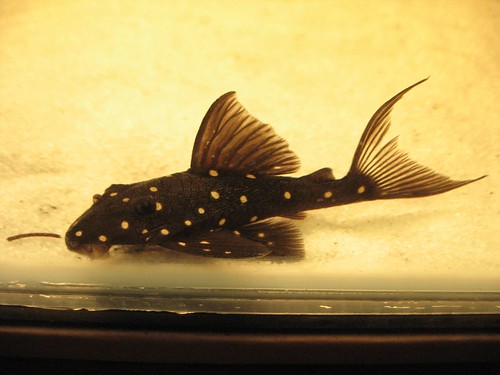
Scientific Name : Liosomadoras oncinus
Family : Doradidae
Common Name : Jaguar Catfish
Maximum Size : 18cm / 7"
Origin : Rio Branco, Brazil - white water river
Temperature : 20-24pH Level: 5.8-6.5
Things to note : The Jaguar catfish (Liosomadoras oncinus) is named after the intangible Jaguar (Panthera onca), and just like its feline namesake, the Jaguar catfish can only be found on the South American continent. It has jaguar skin patterns and is very attractive.
Personal comments : They are quite territorial and yet fragile. Be sure to have a stable tank environment. I've lost my two specimens quite quickly.
Tips : Try to keep a pair, male and female. And have a lot of patience; they do not move at all when there is light, and they are very sensitive to light!
......................................................................................
Sexual dimporphism / reproduction : Determine the sex of a Jaguar catfish is easy, but reproduction has not yet occurred in captivity. The female fish is shorter than the male and has a heavier belly. You can see the male's reproductive organ at the anterior edge of his anal fin.
Feeding: In addition to the leftover food it will scavenge from the bottom, the Jaquar Catfish should also be fed sinking carnivore flakes, pellets, tubifex, and bloodworms.
Behaviour in captivity: Unlike many other popular catfish species, the Jaguar catfish does not form schools. It is a highly territorial species and this must be taken into consideration when you set up your aquarium. It is possible to house several Jaguar catfishes in the same aquarium if it is large enough, but this calls for a clever aquarium decoration that brake up the aquarium into several different territories. There must also be plenty of hiding spots throughout the aquarium. Include driftwood and pieces of PVC pipes or similar. If you hear strange sounds from the aquarium at night, it is Jaguar catfishes trying to stake out their territories. Rivaling the Jaguar catfishes will rotate the spines of their pectoral fins at the base; thereby producing a sound somewhat similar to a foghorn or tuba.
As nocturnal predators, these catfishes should only be maintained with community fishes of equal or greater size. As one of the most beautiful of all South American catfishes, the Jaguar catfish can be recognised by its striking yellow blotches and dark lines on a brown and white body.


 - Rio Sao Francisco, Brazil
- Rio Sao Francisco, Brazil - Rio Sao Francisco, Brazil
- Rio Sao Francisco, Brazil
 Things to note: L282 is a beautifully adorned pleco that rarely comes even during the export season. As it is a spiked pseuda do take note that it will have a huge temper to match its beauty.
Things to note: L282 is a beautifully adorned pleco that rarely comes even during the export season. As it is a spiked pseuda do take note that it will have a huge temper to match its beauty. Things to note: The Golden Nugget is very beautiful fish, and relatively undemanding.
Things to note: The Golden Nugget is very beautiful fish, and relatively undemanding. Things to note: The Snowball Pleco is interesting to keep and is best identified by its teeth, which are made up of four large rasping plates.
Things to note: The Snowball Pleco is interesting to keep and is best identified by its teeth, which are made up of four large rasping plates.
 Things to note: A man-made variant of the Common Bristlenose, the Long fin Ancistrus is commonly captive bred. It appears impossible to identify to species primarily due to a lack of original locality information .
Things to note: A man-made variant of the Common Bristlenose, the Long fin Ancistrus is commonly captive bred. It appears impossible to identify to species primarily due to a lack of original locality information .
 Things to note: L160 is one of the sharp spiked and spotted pseudas. Hence it is extremely boisterous and territorial, and care must be taken to ensure that there is sufficient space for it to call its own. Aeration and pH are also important factors. The flow rate of the powerhead is not important. Note that young fish are extremely sensitive to ammonia and nitrite, and overfiltration is always recommended.
Things to note: L160 is one of the sharp spiked and spotted pseudas. Hence it is extremely boisterous and territorial, and care must be taken to ensure that there is sufficient space for it to call its own. Aeration and pH are also important factors. The flow rate of the powerhead is not important. Note that young fish are extremely sensitive to ammonia and nitrite, and overfiltration is always recommended. Things to note: With its mazy and attractive patterns this pleco makes a good tankmate in a small pleco comm tank.
Things to note: With its mazy and attractive patterns this pleco makes a good tankmate in a small pleco comm tank. Things to note: One of the most popular peckoltia species in the market, Leopard Frog Plecos are one of the species that have been bred successfully by hobbyists.
Things to note: One of the most popular peckoltia species in the market, Leopard Frog Plecos are one of the species that have been bred successfully by hobbyists.